As I headed south on Green Street one recent Tuesday evening to try a new West Loop restaurant, a pleasant flow of foot traffic stomped west on Madison. They were downtown workers, no doubt, heading home to their airy lofts with those stellar skyline views. It struck me, as I waited for cars to pass, that this was not a sight I would have seen 10 years ago, or perhaps even five.
There were plenty of chic loft apartments back then as well as galleries and some great restaurants, but the neighborhood, bounded roughly by the Chicago River, the Eisenhower Expressway, Ashland and Grand, simply hadn’t hit critical mass. Not in terms of shopping or convenience or most notably, population. On weekends, and after six during the week, the West Loop was eerily quiet, a strange atmosphere considering how few vacant lots lined its streets. All of those buildings and no people.
But a steady stream of development had been occurring behind those deceptively passive brick facades, the ones that once housed textile companies, food producers, warehouses and offices. Increasingly, they were becoming home to loft condominiums and professionals who worked in nearby Loop offices. Apart from the balconies that appeared on some old buildings, however, their brick exteriors remained the same.
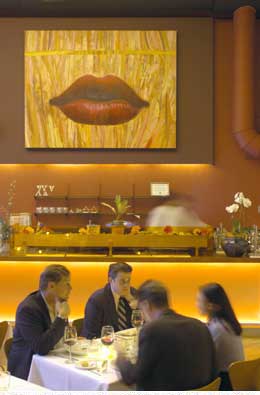 Steadily, new condo buildings were added to the mix, often imitating their industrial cousins, with high ceilings, exposed ductwork and other loft-like features. The population continued to mount – and to complain about the neighborhood’s lack of retail and services. There’s much less for them to complain about today with a new Walgreen’s and a new Dominick’s, both on Halsted. Other businesses, from salons and gyms to cafes (the addition of Starbucks, of course, made some celebrate and others moan) and cleaners have opened at a steady clip. And let’s not forget the restaurants that took a chance on the neighborhood when it was known mostly for raw food, shipped by the ton in and out of the Fulton Market.
Steadily, new condo buildings were added to the mix, often imitating their industrial cousins, with high ceilings, exposed ductwork and other loft-like features. The population continued to mount – and to complain about the neighborhood’s lack of retail and services. There’s much less for them to complain about today with a new Walgreen’s and a new Dominick’s, both on Halsted. Other businesses, from salons and gyms to cafes (the addition of Starbucks, of course, made some celebrate and others moan) and cleaners have opened at a steady clip. And let’s not forget the restaurants that took a chance on the neighborhood when it was known mostly for raw food, shipped by the ton in and out of the Fulton Market.
Since those days, the West Loop has become one of the city’s top destinations for diners thanks to old standbys and new additions such as Butter, 130 S. Green, my destination on the evening in question.
More convenience, services
The restaurant, a spacious, sleek and comfortable room, opened in April with chef Ryan Poli in the kitchen and owner Jason Chan out front. At 27, the chef’s talents far exceed his years. On the other hand, he also has the experience to explain why he is so good at what he does despite his age. He has worked in kitchens in Europe as well as at Le Francais in Wheeling and the French Laundry in Yountville, California, both nationally known, critically acclaimed restaurants.
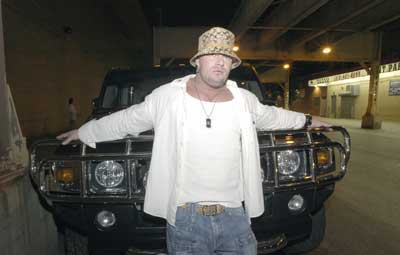 No matter what one orders at Butter, the chef’s risotto with forest mushrooms, asparagus, white truffle oil and mushroom broth should be in the mix. And if truffle oil is your thing, you’ll be delighted when the popcorn arrives. You may never be able to eat the movie theater stuff again without sneaking in your own bottle of truffle oil to liven it up. If you can get the chef to whip up his contemporary version of a shepherd’s pie, you may find yourself thinking about it days later. You’ll also remember how casual and comfortable Butter is, despite very serious food and impeccable though playful presentation.
No matter what one orders at Butter, the chef’s risotto with forest mushrooms, asparagus, white truffle oil and mushroom broth should be in the mix. And if truffle oil is your thing, you’ll be delighted when the popcorn arrives. You may never be able to eat the movie theater stuff again without sneaking in your own bottle of truffle oil to liven it up. If you can get the chef to whip up his contemporary version of a shepherd’s pie, you may find yourself thinking about it days later. You’ll also remember how casual and comfortable Butter is, despite very serious food and impeccable though playful presentation.
You’ll be thankful for the no-attitude service you got at Butter, and then you might agree that indeed, the West Loop is turning soft.
Not that that’s a bad thing. The West Loop has always had a hard edge, once in the heyday of manufacturing, its only identity. That sparseness continued through the first phases of residential development, when this was the place for people who wanted the authentic urban experience: the concrete and glass, the brick and steel, the majestic skyscraper vista and hardly a speck of grass to be found.
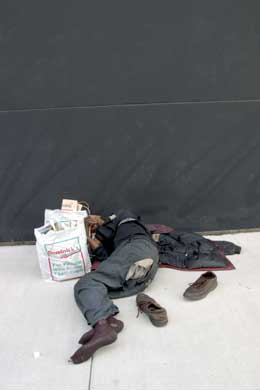 But how real is the urban experience if you have to travel miles for groceries – at least the kind that aren’t hanging from hooks, hooves intact? Isn’t real city living about convenience? The look can be hard, but the living should be easy. And like the loft apartment, that staple of West Loop living, the neighborhood has become softer and more refined. Just as newer West Loop developments temper exposed ducts with drywalled ceilings and complement concrete columns with granite counters, the neighborhood has balanced its gritty industrial flavor – the humming refrigeration trucks, bustling docks and whirring forklifts – with day spas, fine dining and gourmet groceries.
But how real is the urban experience if you have to travel miles for groceries – at least the kind that aren’t hanging from hooks, hooves intact? Isn’t real city living about convenience? The look can be hard, but the living should be easy. And like the loft apartment, that staple of West Loop living, the neighborhood has become softer and more refined. Just as newer West Loop developments temper exposed ducts with drywalled ceilings and complement concrete columns with granite counters, the neighborhood has balanced its gritty industrial flavor – the humming refrigeration trucks, bustling docks and whirring forklifts – with day spas, fine dining and gourmet groceries.
That’s quite a change for the neighborhood there used to be just four reasons for visiting: Greek Town, Oprah, the United Center and the trailblazing Vivo restaurant.
Restaurant row
“Back in the early ’90s there was nothing out here,” says Jerry Kleiner, who opened Vivo and later Marche, and was honored on May 20 with an honorific street name proclaiming Randolph “Jerry Kleiner Way.” The brown sign hangs at Randolph and Green in front of yet another of his restaurants, the hyper-stylish Red Light.
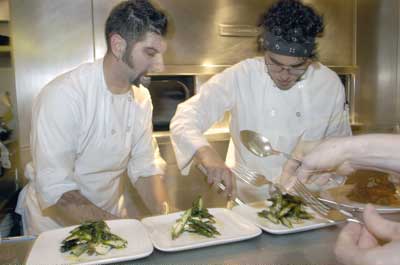 “Nobody lived here, except for a few artists in Green Street Lofts; there were no businesses, no developments on Washington or Madison,” Kleiner says. “There was nothing.”
“Nobody lived here, except for a few artists in Green Street Lofts; there were no businesses, no developments on Washington or Madison,” Kleiner says. “There was nothing.”
Now there is plenty. And there are dozens of reasons to go to the West Loop, many of them involving carefully crafted, chef-driven restaurants. On Randolph, where Kleiner and former business partner Howard Davis first made their mark, there is One Sixtyblue, 1400 W. Randolph, where chef Martial Noguier presides. He is a stickler for details, and a perfectionist when it comes to creating contemporary American cuisine influenced by his native France. When he visits your table you get the sense that he truly cares what you think of his creations and not just because his boss (Michael Jordan) is himself such a demanding perfectionist.
At the east end of the strip, across the expressway, chef Paul Kahan’s newest venture, Avec, 615 W. Randolph, is an intimate room where a long narrow shape and cedar-lined walls are reminiscent of a sauna.
Small, crafty plates of simply prepared food and unique wines by the glass are the draw here. One of the must-try items on the menu is the chorizo-stuffed medjool dates with smoked bacon and piquillo pepper-tomato sauce. Avec also has a nice collection of European artisan cheeses, and house-made sausages for the rustic, country dining experience.
Next door to Avec, which Kahan technically refers to as his “wine bar,” is the fine-dining, white and bright restaurant Blackbird, where the verjus glazed organic pork belly with braised cabbage, golden raisins, fried capers and arugula is a dish that no one should go through life without eating at least once. And just down the street, at Kleiner’s Red Light, 820 W. Randolph, chef Jackie Shen has recently created what she calls “steak and eggs,” a delicious tar-tare and quail egg concoction served in a one-bite spoon.
A club scene, if that’s your thing, also has blossomed in the West Loop, though like the early residential development, much of it is disguised beneath a cool industrial skin. Reserve, 858 W. Lake, is currently the reigning king of the late-night club scene in all of Chicago, and not just the West Loop. With a hip-hop and techno soundtrack thumping upstairs and a more casual bar downstairs, the place is a popular draw for urbanites, suburbanites and celebrities, such as rocker Lenny Kravitz, who recently paid a visit.
Reserve offers a “liquor locker” program, where patrons can store their high-end booze, along with bottle service at private tables. Club-goers can also order regular old drinks from the waitresses, who carry none of the too-cool-for-school attitude many club employees do. Lest you forget where you are, the El screams by a second-floor window at eye level in a fantastic display of urban life-as-art.
Greater potential
Kleiner says back when Vivo first opened, the only action in the area revolved around the meatpacking businesses, with forklifts buzzing about, and ladies of the night hawking their wares. And the El was just a noisy way for people to pass through the West Loop on their way downtown. Who could have predicted that the area would now be so stylish?
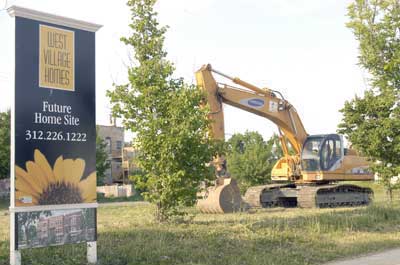 Along Randolph Street there are blooming planters, and curbside parking lined with shiny SUVs. Kleiner envisioned the potential of the area after seeing loft-heavy neighborhoods in New York. Visionary residential developers had seen the same potential, gradually converting industrial buildings into apartments and later, condos.
Along Randolph Street there are blooming planters, and curbside parking lined with shiny SUVs. Kleiner envisioned the potential of the area after seeing loft-heavy neighborhoods in New York. Visionary residential developers had seen the same potential, gradually converting industrial buildings into apartments and later, condos.
Now the neighborhood is home to the Chicago Antique Market, which bills itself as an “urban treasure hunt” and takes place on Randolph between Ada and Odgen on the last Sunday of the month from May to October. Following models set by London and Paris, this European-style antique and collectibles market gives the area a sense of style that only this sort of dramatic setting could support.
But don’t take my word for it. An investment story in the May 2005 issue of GQ Magazine touted three West Loop developments: 817 W. Washington, 909 W. Washington and 1018 W. Monroe, as great places to live and tremendous bargains. The units range from the $390s for a 1,285-square-foot two-bedroom condo at 909 W. Washington, to the $440s for a 1,700-square-foot two-bedroom duplex with a 600-square-foot private deck at 1018 W. Monroe. GQ called the West Loop “a burgeoning neighborhood filled with chic, new loft-like spaces…and young working single dudes and families.”
“Burgeoning” is too much of a real estate cliché to describe what’s happening in this neighborhood, but nonetheless, Kleiner believes there is still a lot of room for development. And he’s willing to take some of the work on himself.
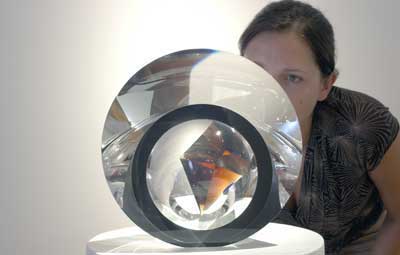 “Since I opened Vivo (which he has since sold) there have been thousands and thousands of residential units filled,” he says. “But there’s still tremendous growth potential. I tried to get art galleries out here, but they all wanted to be around Wells Street. Now everyone wants to be out here. I’m trying to convince hair salons and boutiques to come in. There are no eyeglass stores, jean stores, little shoe stores. Because I don’t see anyone else doing it, I’m going to do it. That will really complete the whole community. Bakeries, coffee shops. I saw the Starbucks, but I’d like to see more underground, independent coffee houses, tea houses, stuff like that. The neighborhood to me, honestly? I’d say it’s at 50 percent.”
“Since I opened Vivo (which he has since sold) there have been thousands and thousands of residential units filled,” he says. “But there’s still tremendous growth potential. I tried to get art galleries out here, but they all wanted to be around Wells Street. Now everyone wants to be out here. I’m trying to convince hair salons and boutiques to come in. There are no eyeglass stores, jean stores, little shoe stores. Because I don’t see anyone else doing it, I’m going to do it. That will really complete the whole community. Bakeries, coffee shops. I saw the Starbucks, but I’d like to see more underground, independent coffee houses, tea houses, stuff like that. The neighborhood to me, honestly? I’d say it’s at 50 percent.”
Eric Sedler, president of West Loop Community Organization, wouldn’t argue too strongly against that.
“I think that there’s plenty of room for more development,” says Sedler, a six-year West Loop resident. “The two main drawbacks anymore are traffic and parking. It used to be that you could sort of just park anywhere. It’s much better than Lincoln Park and Lakeview, but obviously when you have thousands of people move in, traffic and parking are going to be problems.”
West Loop expansion
Sedler says he can deal with those problems, though, as long as more retail stores round out the West Loop and promote more foot traffic. He also is open to the organization changing its borders to include the naturally expanding area west of Ashland. The West Loop Community Organization considers Ashland the its western border, but perhaps not for long.
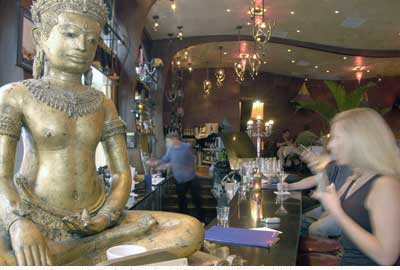 “Whether or not that area would be folded into the West Loop is an open question,” Sedler says. “One could argue that it may make sense for us to go a little westward. But we would be equally happy to help another organization form, too. Expansion is not something we’re seeking, but it’s something that could happen.”
“Whether or not that area would be folded into the West Loop is an open question,” Sedler says. “One could argue that it may make sense for us to go a little westward. But we would be equally happy to help another organization form, too. Expansion is not something we’re seeking, but it’s something that could happen.”
Projects like West Village Homes, a $25 million development at 2112 W. Madison, might hurry that expansion along. A joint venture between New West Realty and the City of Chicago, West Village Homes will comprise up to 110 new affordable and market-rate single-family homes, along with two-flat and three-flat condos built on city-owned vacant lots west of Damen.
There are other westerly projects in the works, too, including Westhaven Park, the $200 million mixed-income redevelopment of the Chicago Housing Authority’s Henry Horner Homes. Plans for phase I call for a 113-unit mid-rise building with 79 market-rate and affordable condos and 34 CHA units. At press time, prices started in the $210s, and more than 85 percent of the condominiums had been sold.
To the east, between Halsted Street and the Chicago River in an area christened the Fulton River District, development has taken the same quiet, steady path as in the blocks to the west. Residents have been migrating here for roughly a decade, since China Club Lofts opened at 616 W. Fulton.
Jameson Realty Group and MCZ Development followed that project with a number of high-profile loft projects that added population to these convenient but sparse blocks directly west of the Loop.
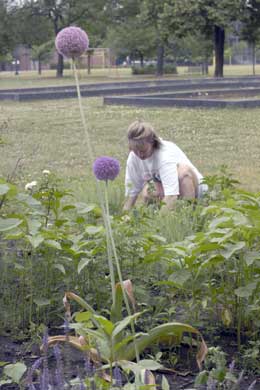 Now, Jefferson Tower, a 24-story condo tower underway at 200 N. Jefferson, is poised to accept its first occupants early next year. The highrise’s 198 one-bedroom and one-bedroom-plus-den condos were designed to be smaller and more affordable than many units in the area. They range from 789 to 1,330 square feet, with prices starting at $235,000.
Now, Jefferson Tower, a 24-story condo tower underway at 200 N. Jefferson, is poised to accept its first occupants early next year. The highrise’s 198 one-bedroom and one-bedroom-plus-den condos were designed to be smaller and more affordable than many units in the area. They range from 789 to 1,330 square feet, with prices starting at $235,000.
A Jewel grocery store planned for Desplaines and Kinzie and a MetraMarket featuring 200,000 square feet of street-level retail space will help the neighborhood evolve and over time, meld with the area west of Halsted that people traditionally think of as the West Loop.
Savvy buyers, it seems, are well aware of the growth that’s occurred west of Halsted, and they’re hoping it will spread.
“I started out wanting to be in Bucktown or Lincoln Park,” says Chris McComas, who bought a 1,300-square-foot unit in China Club Lofts in April of 2004. “I looked at the spaces I could get for my money, and my Realtor told me there were more options in the West Loop for lofts.”
McComas found what he was looking for, a large loft with a balcony and 14-foot timber ceilings. Today, the patch of West Loop between the river and Halsted has the quiet sparseness and lingering industrial flavor that permeated the area west of Greek Town in the early ’90s. Already, though, there are clear signs that things are changing.
“Everyone is always walking their dogs,” McComas says. “And you see people jogging. It’s not Lincoln Park, but it’s not an industrial no-man’s land, either.”
Neighborhoods fusing
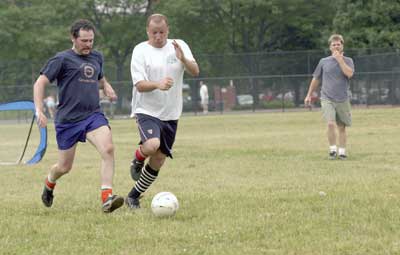 Charles Huzenis, a developer who has made the Fulton River District his pet project and is responsible for Jefferson Tower, also hears the train coming around the bend. Then again, he may have a sharper ear than most. He’s been there for years, watching his developments fill, looking for new opportunities and being thankful that so many businesses have chosen to move their offices west from the heart of the Loop to Wacker. Citing, among others, a recent move by LaSalle Bank, in which 5,000 employees shifted a few blocks to the west, Huzenis says he imagines more of the same in the area between the river and the expressway.
Charles Huzenis, a developer who has made the Fulton River District his pet project and is responsible for Jefferson Tower, also hears the train coming around the bend. Then again, he may have a sharper ear than most. He’s been there for years, watching his developments fill, looking for new opportunities and being thankful that so many businesses have chosen to move their offices west from the heart of the Loop to Wacker. Citing, among others, a recent move by LaSalle Bank, in which 5,000 employees shifted a few blocks to the west, Huzenis says he imagines more of the same in the area between the river and the expressway.
“It’s a driving force for people to roll out of bed and walk to work,” he says.
That was certainly the main reason Jack Zimmerman moved from his ranch house of 23 years in west suburban Elmhurst to a soft loft in Huzenis’s Randolph Place, a condo conversion at 165 N. Canal.
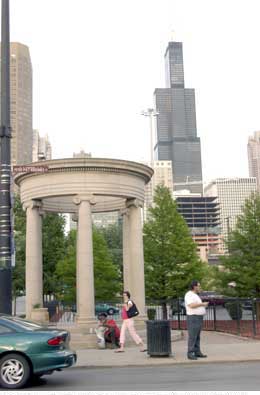 When in 1999 he landed a job in the Lyric Opera of Chicago’s public relations department after a long career at the Ravinia Festival, Zimmerman and his wife decided it was finally time to move downtown.
When in 1999 he landed a job in the Lyric Opera of Chicago’s public relations department after a long career at the Ravinia Festival, Zimmerman and his wife decided it was finally time to move downtown.
“I had spent many years commuting in a car to Highland Park and when I got the job at Lyric Opera I took the train in a few times and I thought, ‘I don’t even want to do that,'” he says. “I wanted to get up in the morning and walk to work.”
And that is what he does today. And so does his wife, Char, the Lyric’s principal clarinetist. The thick walls in their building allow Char to practice without disturbing anyone, which is important considering that for a long time the only neighborhood they knew was the one inside their building.
“The Dominick’s at Skybridge opened, and we always had the Presidential Towers market, and there’s a dry cleaner in the building, so it’s gotten really easy to live here,” he says. It will only get easier, especially when Kleiner opens his “nueva Latino” restaurant in the building formerly occupied by Drink. He’s also working on a lounge that will serve food 311 N. Sangamon – on the west side of Halsted – called Victor Hotel, which should open this summer.
“I think it’s phenomenal, the tremendous growth east of the expressway and the connection and fusion between the two neighborhoods,” he says. “It’s just spilling over, one into the next. East of the expressway (the area) is getting to the point where it could really support a whole community. We just need more things, more boutiques, everything.”
As for the traditional West Loop, where Kleiner hung out his shingle a decade and a half ago, it’s farther along but still has a ways to go. Still, he can hardly believe the transformation.
“Oh my God,” he says. “I mean come on, that’s like a thousand degrees, like three-times-around difference. It used to be that going to the West Loop had a little danger to it, a little intrigue. It was a secret, hidden place. Now you see baby strollers down the street, schools and parks. It’s just night and day, the difference. It’s like going from a ghetto into something beautiful. Like a beautiful flower, just continuing to blossom.”
See, even Kleiner thinks the place is getting soft.
